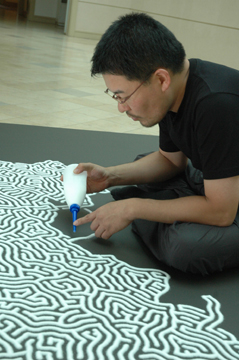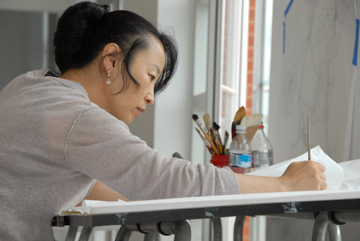

| For more information about this article or gallery, please call the gallery phone number listed in the last line of the article, "For more info..." |
November Issue 2006
Davidson College in Davidson, NC, Features Works by Japanese Artists
Three Japanese artists, Takasumi Abe, Yamamoto
Motoi, and Yuri Shibata, currently in residence at Davidson and
seven other associates elsewhere in the Carolinas are creating
expressions of their culture's traditional belief in the close
bonds between humans' inner nature, and the natural world around
us. The three are part of a project entitled Force of Nature,
co-curated by Brad Thomas, Davidson's art gallery director. The
artists' installations will be on view in Davidson's Smith and
Van Every Galleries through Dec. 6, 2006.
Tonya J. Clay, visiting assistant professor of art at Davidson,
said the work of all three artists "reaffirms the constantly
changing nature of physical existence".
Clay said, "Each of their works comments on, or recreates,
the unseen process of transition from the physical to the 'non-physical'
and back again. Moreover, each does so with a formal clarity and
organization consistent with traditional Japanese aesthetic".
 Yamamoto Motoi
Yamamoto Motoi
Yamamoto Motoi has created breathtakingly precise and huge labyrinths of salt as a reflection on life and death that was prompted by the death of his sister several years ago. One of his creations occupied the entire 429-square-foot floor of the college's Edward M. Smith Gallery in the Belk Visual Arts Center.
"Salt represents purification in Japanese culture," Clay noted, "It is found all over the planet, predominately in the water of oceans, and is a necessary mineral for health. But too much of it can be fatal, so it is both restorative and degenerative. Salt is a force of nature that draws out water from the cells of living things, and with continued exposure turn things to dust."
 Yuri Shibata
Yuri Shibata
Yuri Shibata has been methodically collecting dust, mixing it with printing oil, and pressing it into monotype prints. She considers the dust to be a historical record of the people and events in a place, representing the physical transition of objects from existence to non-existence. By using it for a new creation she symbolically gives new life to the original object.
Shibata is suspending several of her prints over a large, latex "breathing" dome on which pictures of many human torsos are sequentially projected. "The piece represents a universal human life," said Clay. "Meditating on the act of breathing and the cyclical shape of the dome, one understands that each breath is an act of change, and is part of the cycle of life. The monotypes of dust hanging above likewise represent the history of the people and events that occurred during the creation process."
Tkasumi Abe has created a large spherical pod built of welded steel rods. This structure is covered with stiffened tissue paper in order to amplify the sound of clouds, which he captured by floating his iPod high into the sky one day beneath helium-filled garbage bags. Clay said, "Abe examines physical processes and entities that are not perceivably visible. We cannot touch them, but we take it for granted that they exist. He brings to our attention the fact that sound, a collection of vibrating molecules, is also a physical thing."
Clay continued, "Inside Abe's sphere the viewer has the opportunity, not only to see and hear the sound, but also to enter it, to become part of the sound, as it vibrates all around the space in which he/she stands. It confirms that sound is actually physical, even though we can't see it."
The Force of Nature project bubbled up from a conversation several years ago between Davidson's Brad Thomas and Mark Sloan, director of the Halsey Institute of Contemporary Art at the College of Charleston. "Mark and I were both interested in the Japanese philosophy of inner and outer nature," said Thomas. "It's the idea that we're connected to the land, that our inner selves and the outer world are one in the same."
Sloan had brought Japanese artist Rikuo Ueda to Charleston in 2001, where Ueda created one of his trademark "wind drawing machines," where a stylus draws on paper as it is driven by the wind creating fluid abstractions. Sloan and Thomas began wondering if there were other Japanese artists using natural materials and processes.
The curators explained that the connectivity of the human spirit to nature is rooted in Asian culture. It's reflected in such rituals as the cherry blossom festival and the elaborate tea ceremony. During certain festivals of the full moon, monks expose containers of sake to moonlight to catch the reflection before they drink it.
The philosophy for the project also has roots in the earth and environmental art movement that emerged in the 1960's and 1970's. Some Japanese artists began going beyond representations of nature in a painting, to actually intervening with nature in their work. Japan has played host to several international art exhibitions exploring the fertile terrain of art and nature.
The curators also hope the project will forge the participants into a support network in their homeland, where their traditional artistic vision is overshadowed and underappreciated. Thomas said the primary form of contemporary Japanese art in today's world is the in-your-face, cartoonish "manga," or "animae" style, which features graphics, action, and violence. "That movement has been extremely successful, but Japanese art is being pigeonholed into that one idea," said Thomas. "Mark and I wanted to find contemporary Japanese artists who express the traditional philosophy in modern ways."
Sloan's colleague, Noriko Fuku, a New York
and Kyoto-based curator, was enthusiastic about the idea, and
ultimately served as guide and translator when the two curators
traveled to Japan in Nov. 2003. They began with a list of a half-dozen
artists, but referrals spurred many other visits, and the team
eventually visited with approximately thirty artists and countless
arts officials. They discovered an art world that receives much
less support from granting agencies, public organizations, and
professional networks than is common in America. Thomas said many
Japanese artists who do not work in the stereotypical Japanese
aesthetic, tend to be somewhat isolated and are under-recognized
for their work.
By bringing them together in America, they will come to know each
other and each other's work, and build a support network. "Already
a number of them have been communicating by e-mail," said
Thomas. "The project will have a big influence in Japan following
the residencies in America."
The overall cost of the project is approximately
$250,000, which is shared between the six institutions involved:
Davidson College, UNC-Charlotte's College of Architecture, the
McColl Center for the Visual Arts in downtown Charlotte, the Halsey
Institute at the College of Charleston, Winthrop University, and
Clemson University's College of Architecture in Charleston.
The stipulation that the artists use natural processes or products
not only reflects the traditional Japanese philosophy, but it
simplified logistics by eliminating the need to ship artwork or
materials from Japan to the USA.
"They're using natural materials, but their ideas are as progressive as any other large-scale art projects being produced today," said Thomas.
Curators Sloan and Thomas chose the title, Force of Nature, as a positive pull, rather than a powerful push, and anticipate that the project will blossom into an intercultural exchange. "We hope that these projects will pull in students at the institutions, school children in the area, and other members of the public who want to be involved," said Thomas. "We want them to be engaged with the project in as many ways as they can envision."
With an eye toward involving the public, the project web site, (www.halsey.cofc.edu/fon.html), is being updated daily to show the progress of each of the artists.
The project will extend even beyond the residencies and exhibitions. Part two will be a capstone exhibition at Sumter County Gallery of Art in Sumter, SC, coinciding with the Spoleto Festival 2007. That final exhibition will provide an opportunity for the public to see the entire scope of the project in one location. It will consist of documentation of each artists' process, as well as photographs of some artists by Mitchell Kearney, along with maquettes and working drawings of the projects, and any artwork that is left after the fall exhibitions. In addition, a book will be produced that will serve as a document of all the artists, installations, and events. This vital document will require additional fundraising beyond the initial cost of the project.
In the long run, the curators hope that the
artists involved will be forged through their common experience
into a network that will increase the profile for contemporary
Japanese artists who believe in their country's traditions that
no boundaries exist between the inner and outer worlds in which
humans work, play, and create.
For further information check our NC Institutional Gallery
listings or call Brad Thomas at 704/894-2519. For more info, and
artist profiles, visit (www.halsey.cofc.edu/fon.html).
Carolina Arts is published monthly by Shoestring Publishing
Company, a subsidiary of PSMG, Inc.
Copyright© 2006 by PSMG, Inc., which published Charleston
Arts from July 1987 - Dec. 1994 and South Carolina Arts
from Jan. 1995 - Dec. 1996. It also publishes Carolina Arts
Online, Copyright© 2006 by PSMG, Inc. All rights reserved
by PSMG, Inc. or by the authors of articles. Reproduction or use
without written permission is strictly prohibited. Carolina
Arts is available throughout North & South Carolina.